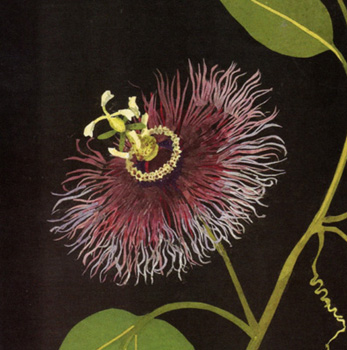 Mary Delany, Detail of Passion Flower, Paper Collage, 1777 First Love Blooms in Molly Peacock’s Paper Garden
If you’ve read my blog: Unearthing Molly Peacock’s Paper Garden, you’ll know how inspiring her book is for those of us struggling to make an art career for ourselves late in life. Having just finished reading chapters “Hound’s Tongue” and “Damask Rose” which relay Mary Delany’s teenage years, it was hard not to shed a tear as Peacock recounts the untimely demise of young Mary’s first suitor, a handsome military fellow, who she reluctantly refuses to marry; he’s so infatuated with her he steals a paper cut out she made and places it under his pillow (sigh)! It’s all so bitter sweet as not long after Mary, a blossoming young thing, is forced to marry the wealthy, curmudgeonly old Mr. Pendarves! Peacock bases each chapter of the book on one of Mary’s floral collages… analyzing each one and carefully and thoughtfully drawing out the fragments of Mary’s life that seem to be in sync with the types of flowers she re-creates – she’s such a gifted story teller! I love too that Peacock fuses her own similar life circumstances with Mary’s – drawing us closer to author and subject. It’s hard not to get the feeling that even though these two lived centuries apart that Molly Peacock and “Mrs. D” might have been the best of friends. This book is gold!
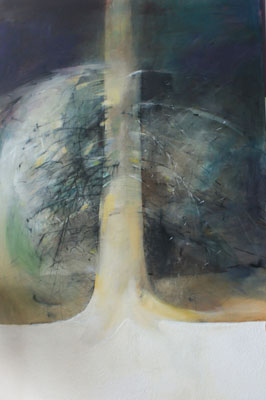 Margit Hedig, "Journey 23", Mixed Media Painting Journey through the Gatineau Hills with Margit Hideg
In August I visited the Gordon Harrison Gallery on Sussex to view the work of another Shabooya colleague. Margit Hideg’s “Journeys” is a series of mixed media landscape paintings inspired by Quebec’s magnificent Gatineau Hills. A frequent visitor to the Gatineaus, I felt an instant connection to it. This revealing series allows one to discover, explore and wander through the natural terrain through the unique visual perspective of the artist as well as feel its impact on her inner being. I was taken up by the calm, earthy colours, gorgeous textures and delicate line detail found in Margit’s work. In describing herself as an artist, she states: “Each of my paintings is a personal expression. Emotional and intuitive. My paintings are always charged with content taken from the natural world.” “Journeys” is not to be missed!
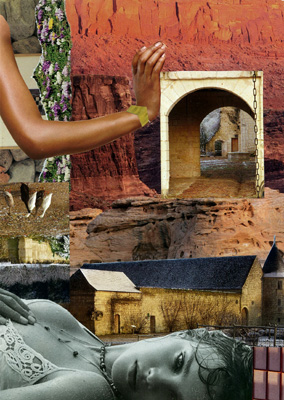 Andrea Harrison, "Stay There", Collage, 2011 Andrea Harrison Defies Her Comfort Zone
A veteran of my Basic Collage class, Andrea Harrison continues to amaze me with her burgeoning collection of new collages… at least 14 plus I’ve counted so far! A few of these she has even done using Photoshop. I’m so excited to see her extending the bounds of collage to a virtual medium. Now she’s even sharing her collages with family and friends as well as giving them as gifts to loved ones. So glad to see you making collage an integral part of your world, Andrea – a gift made from the heart and hands is priceless.
Drawing & Painting Classes with David Kearn
Through my blog entry Defying My Comfort Zone, you learned about the fabulous plein air class I took with fellow artist David Kearn. If any of you in Ottawa are interested, he’s offering fall and winter classes in drawing and painting. Be sure to check out his website for details regarding these as well as new portfolios he’s posted of his latest figurative and plein air works. David’s a very knowledgeable, attentive teacher as well as a wonderful artist; I just love his gentle manner and English accent!
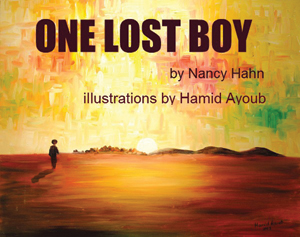 One Lost Boy children's book illustrated by Hamid Ayoub Hamid Ayoub’s Lost Boy Paintings
Recently, another Shabooya colleague of mine, painter Hamid Ayoub had his colourful paintings of the African landscape and its people published in a children’s book: One Lost Boy which relays the true story of a young Sudanese boy fleeing civil war who makes a new life for himself in the US. It’s fitting that Hamid was chosen to illustrate this narrative because his own tale of flight is just as harrowing. This summer he promoted his work at a show in New York. Congratulations, Hamid – your paintings will now be part of the imaginative landscape of young readers all around the world!
Atrium Show “Gala”
This month, Maggie “Free Spirit” Jordan and I have started planning the details for my opening at the Atrium Gallery on November the 8th (mark your calendars!). We’ve just gone over a dizzying array of information related to serving food and drink (so many rules!), rounding up volunteers, as well as familiarizing ourselves with the gallery setup and opening etiquette. I’ve learned so much from Maggie who has a real savoir faire for these types of affairs. Although we’ve ironed out a number of details, we’re still debating that age old question – what are we going to wear!?! … tiaras and gowns!!!?… Maggie’s thinking of going formal; I’m still up in the air! It’s going to be a mixed bag. If you can make it, I’d love you to come just as you are!
Michael Jackson Rocks My World Again!
I’m a BIG fan of Michael Jackson. This summer I lamented not being able to get tickets to Cirque du Soleil’s: The Michael Jackson Immortal World Tour in Ottawa; this week my husband got two free tickets to the show – I’m on cloud nine!
That’s it for my news … I’d love to hear about any exciting bits and bytes going on in your creative life.
 Sneak peak of Atrium Gallery mixed media/collage journal page "Ghosts of the North, Part I" (2011) inspired by a dream about my husband. Dreams make the perfect subject matter for collaging; their surreal (unreal) quality can give you a great jumping-off point for creating art.
Why bother collaging your dreams (or nightmares)? Well, a seemingly random series of images coming together in our mind to form events that don’t initially make sense, might suddenly if we choose to explore them through the process of collaging. It’s most exhilarating to transform your dreams into some kind of material reality so you can investigate them further. As you begin to search for the right pieces to capture the mood and territory of your dreamscapes, you may find that their messages becoming clearer. The more deeply you probe these worlds by uncovering the symbolic meaning behind characters, objects or places you find in them, the more meaning you may derive to decode their cryptic messages. I’ve noted some of my dreams are easily decipherable, while others are complete mysteries. For example, I often dream about all my teeth falling out: a not-so-subtle reminder to visit the dentist! And yet, I don’t know why a neon-eyed crocodile chases me across a deserted pier in the midst of a stormy sea! Someone once told me that our nightly world of dreams is as real as our waking reality. Further, that we can consciously travel through them in the same way we do in our day time world. In some dreams, I find myself travelling at the speed of light on feet that glide silently above the surface of the ground; other times, I’m falling from a mysterious mountaintop as a stranger watches… no matter what the scenario, my senses are as alive in my dreams as they are in “reality”; my body vulnerable, yet also super-human. One day I’d like to explore this double world theory of dream and reality and see where it leads.
When recording a dream, I recall the information using as many senses as I can to get a clear picture of it in my mind. Writing in stream of consciousness style frees up my ability to write more descriptively. While writing, I don’t pay too much attention to punctuation, grammar or sentence structure: I allow the details to flow from within. Sometimes I find a word, phrase or quote can sum up an image more beautifully than a sentence or paragraph. When referring to physical descriptions of dream characters or places, I reference the names of friends, relatives, actors, movies, TV or familiar artwork to describe them – this helps in the search for imagery later on. At the collaging stage, my journal is my guide but it doesn’t necessarily rule my choice for imagery. Rather, it gives me clues as to where to start exploring for images. I read it over and over until its atmosphere, emotions and characters come alive in my mind; here, working to music that evokes the emotions I felt in my dream really helps. You can’t expect to find every image you need to compose your dream; sometimes using two or three images is enough to set off a whole series of thoughts regarding its mood/spirit. The rest can be filled in with other aspects of your dream: textures, colours, references to its time period, etc.. Sometimes my substrate (paper or canvas size) determines how much imagery I can use (I work small: 2.5 x 3.5 or 8.5 x 6 inches); that means I end up editing all kinds of great images out my collages – but that’s okay; as in writing, editing imagery is a vital part of the process. Besides, leaving out information allows the dream to retain its mysterious qualities. Compositionally, I never fully plan my collage journal pages; I enjoy working intuitively: letting each image dictate what the next should be and where it should fall. This process is much like experiencing a dream – you never know where it will lead you! Often I find I’ll use an image that wasn’t initially in my dream but feels right … sometimes, I wonder if the process of collaging has released this new information from my unconscious mind offering me new insight into my dream. This happened recently when a dead hare and star chart materialized themselves in my journal page: “Ghosts of the North”.
I highly recommend collaging your dreams – it can be such a thrilling, insightful and cathartic experience. Your dream journal doesn’t have to be overflowing… in the last two years, I’ve collected a mere 10 excerpts of my most vivid dreams… 10 gold nuggets worth of ideas to work from for future projects when I feel blocked!
Quick Tips: Collaging a Dream Journal:
– Find a journal you’re comfortable with.
– Place your recording tools beside your bed (pen/paper or digital recording device).
– Record your dreams as soon as you wake.
– Describe it in Stream of Consciousness Style (little to no editing).
– Make comparisons/use a word/phrase to describe characters/events/places in your dream.
– Describe your dream using your five senses.
– Keep your dream journal handy collaging; use it as a guide not a bible.
– Keep a dream dictionary handy or use Google to help decipher dream symbols.
– Be prepared to edit some visual information out of your collage.
– Use music to create the right emotional atmosphere to work in.
Further Inspiration:
Film director Tarsem Singh conjures up the most incredible dream-like imagery in his movies. Check out his trailers: The Cell and The Fall – they’re breathtakingly inspiring!
On-line Dream Dictionary References:
Dream Hawk
The Curious Dreamer
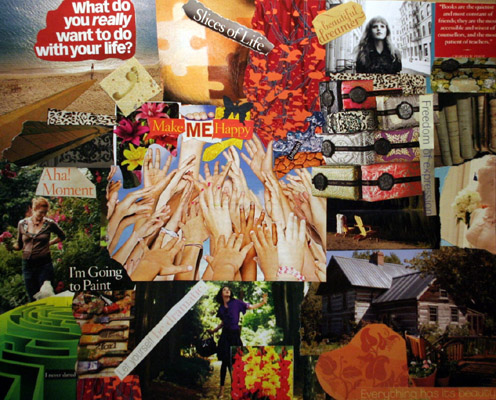 Ruth Watt, Vision Board, Collage, November 2010, 16 x 20 inches I had the pleasure of meeting Ruth Watt for the first time at Dragonfly Dreams studio in Richmond, Ontario. At first she was unsure of how to tackle her vision board but slowly through the process she discovered a way to make it work. Ultimately, her vision was to make time to produce art despite her busy life. Although she described herself as a “procrastinator”, I think many of us face this same challenge of struggling to balance our professional and family life with our own needs and dreams. I thought taking the workshop itself was a good indicator of Ruth’s commitment to doing this. Here are her vision board reflections…
 Ruth Watt, Spring 2011 Ruth, what’s your background?
I work full time as an Administrative Assistant (one of many other duties) in a very busy and stressful office. Home life is also stressful as there are 3 generations living at my house. As far as art goes, I am currently working on a daily journal. I got started in Tole painting and ceramics about 8 years ago and progressed to ATCs and paper projects. I have dabbled in other art but have not found my niche yet.
What attracted you to the vision board workshop?
I had no idea what the vision board workshop would entail and was interested in exploring a new artistic area.
Did you have a vision/dream in mind for it before you began the workshop? If yes, what was it? If not, how did you feel about that?
I tried the “homework” you gave just so that I would have an idea what to do. I was able to envision what I wanted my vision to be but still wasn’t sure what the end product would be.
How did you find the visioning process (ie. closing your eyes, imagining your dream, etc.)? Did you find it helpful in clarifying your goals? How did it make you feel?
I have to admit that I felt a little uncomfortable and unsure of what I was supposed to accomplish but after a few minutes I just let it flow over me and as I relaxed, my inner feelings took over and I was able to see what I was reaching for.
How did you find the process of collaging your vision board? Was visually setting down your ideas helpful to you or revealing?
I really enjoyed the collaging. I was surprised at some of the pictures that I chose and how well they actually fit into my vision board. They felt like random choices but as I moved them around on the board a larger picture came into focus.
Where is your vision board now? Is it working for you?
My board is standing in a corner of my art room near the door so that I can see it every time I leave the room. I also have put photos of it on my blog so that I see it when I go there.
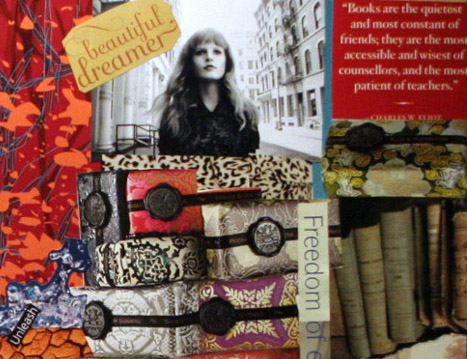 I love the “beautiful dreamer” section of Ruth’s board. It’s so romantic and full of promise! Its sumptuous array of textures and colour contrasts are so jewel-like! I was so relieved that Ruth was able to finally relax during the visioning exercise and thrilled to see the final results of her board! I can’t tell you how many magazine fragments she collected – I didn’t see her finishing it any time soon… especially by the end of the class! But, she did. Her board is vibrant. Its surface abounds with little stories where various characters give insight into her life, personality (ie. that zany repetitive leopard print!) and thoughts. She uses found text fragments beautifully to indicate her elation of discovery; search for knowledge; expressing her desires and calling herself to creative action. I love the way her composition works itself from the centre outwards. In class, she revealed her main image, the multiple hands, represents those vying for her attention… while the outer rim of images reminds her of the things she strives for for pleasure and creative development – a wonderful layout strategy no doubt arrived at by bringing her vision into focus through the act of composing. I truly believe when it comes to collaging, no choice of images is random… each one is a reflection of a part of who we are or wish to be. It was such a pleasure to get to know Ruth through the class. I always find it inspiring to check out her Fleurs de Mon Coeur blog to see what she’s up to creatively. Best with your vision board goals and the latest little addition to the Watt household, Ruth!
Vision Board Tip:
Viewing your vision board on a daily basis helps to increase its power. Just as a magazine, billboard or TV ad you see every day, seeing it on a regular basis helps to ground your dream(s) in your mind as well as keeping it fresh and alive!
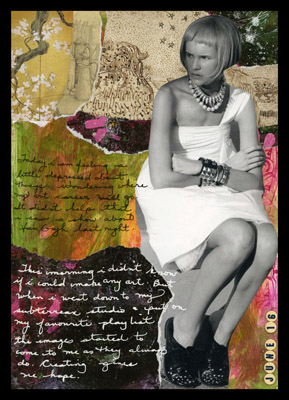 In this journal page I have used magazine fragments of drawings and paintings including one of Vincent Van Gogh's drawings in the top centre and right side of the page. After months of collaging, I decided to try my hand at something new. I love to add bits of imagery from drawings and paintings to my collages; sometimes I wish as well as adding those of others’ works, I’d like to add some of my own – so when fellow Shabooya* artist, David Kearn announced he was giving plein air painting classes this summer, I found it serendipitous. I vowed no matter how busy I was, to fit in at least one class with him. I have little to no experience open-air sketching or painting and was a bit leery of having onlookers gawking at my (probably horrendous!) work in progress. Even so, I put these insecurities aside and signed up for a class.
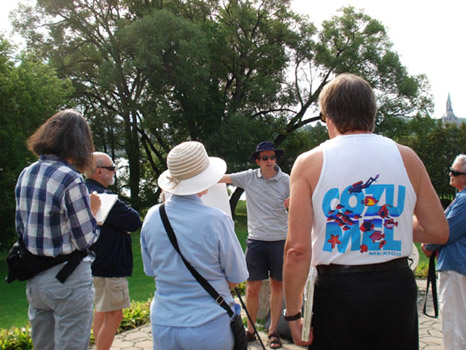 David Kearn (far centre) and students, August 2011 There’s much preparation involved in plein air painting… besides paints, easel and tools, one needs a light portable chair, mosquito repellent, sun screen, plastic bags (for waste and make-shift rain gear), water and a hat (which I hate to wear!) among other things. Saddled up with my gear and my husband’s silly straw hat, I was ready to go! Our location, the beautiful Experimental Farm, is a spectacular place filled with flower, vegetable and rock gardens; an oriental-inspired pond; a dizzying array of trees and shrubs as well as farm animals and quaint buildings. Upon arrival David and his wife France, familiarized us with the surroundings; David gave us newbies a brief recap of the basics of plein air painting; a demo about creating the perfect greens for our paintings as well as a glimpse of his paintings from the previous location, Lac Leamy. Then we were off to find our own little secret spot of inspiration. It took me nearly half an hour to find mine: a dramatic cluster of three magnificent pine trees. I didn’t know if this was the best subject matter – but it certainly was fit for a drama queen! I spent two hours sketching timid studies of the trees and decided to tackle a value study David recommended we do which involved defining the highlight, mid-tones and shadows of our subject matter… well, I did it in my own dyslexic way with a small bit of charcoal and kneaded eraser which David scavenged for me from his painting box (I brought everything but the kitchen sink and forgot those!). I never got to the painting part or proper value study, but did manage to take some photos to inspire me later.
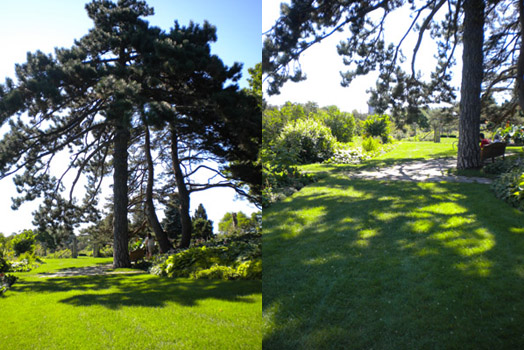 Two views of my dramatic pine trees at the Experimental Farm, Ottawa, August 2011 It was exhilarating to be outside trying to capture some semblance of the pines. Not an exact replica of them, I think my last study still managed to harness a bit of their drama. On his visits to check my progress, David’s gentle demeanour and expert eye led me to discover the beauty of the dark and light shadows underneath the trees — which I could try to capitalize on in future studies… I was delighted by David’s vision of them where they became a giant sacred canopy of sorts; their long heavy branches leaning downwards casting a brilliant stained-glass effect of light and shadow on the grassy carpet beneath. As I sketched to the very last minute of class, I forgot about beating off the ants crawling up my left foot; the flies buzzing around my shoulder and the hot summer sun (thank God for the hat & water!)… I became engrossed in rendering the trees. Time sped by; a feeling of peace enveloped me. Upon leaving, I surveyed the paintings of the other students and marvelled at the way they’d transformed gorgeous beds of flowers into brilliant tapestries and quilt-like blocks of colour. I got the sense that plein air was not necessarily about rendering nature in all its detail, but more like revealing its essence… as a person caught up in detail, that was an eye-opener.
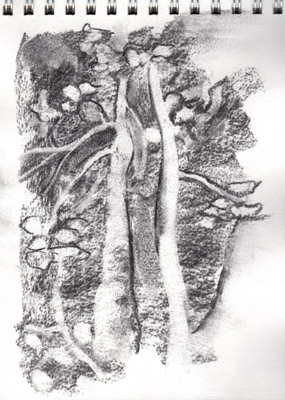 My charcoal study of the pines, August 2011 What a productive day! I felt a teeny bit like an Impressionist, too! I had renewed respect for what my friend Elaine Coombs (the “Tree Whisperer”) does! I definitely want to take more classes next summer. If you’re from the city or visiting, taking a plein air class is a great way to really get to know the beauty of our many parks here in Ottawa. I highly recommend dropping in on one or more of David Kearn’s classes. He’s an excellent instructor and teaches figurative work, too; his prices are very reasonable. As for the gawking onlookers – no one bothered me; not even the tourists! They were all amazingly polite making sure not to block my view of the pines – such courtesy was a pleasant surprise! (If they only knew the mess I was scribbling down!) Have you gone out of your comfort zone to try something new? What did it teach you? – I’d love to know!
* My “Shabooya colleagues”… are a group of artists from the city I met while taking an Artist-Educator Course with the Royal Conservatory (of Toronto). Every day of the course we’d start off with this chant with the word “Shabooya” in it, hence our name.
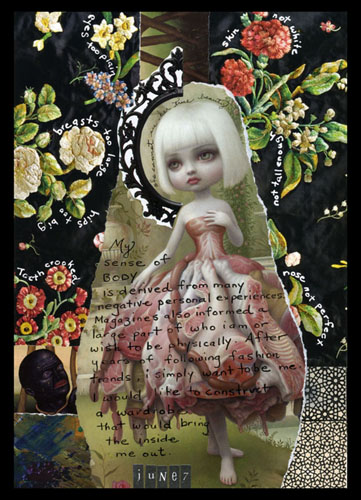 Michelle Casey, "Body Talk", Mixed Media/Collage, June 7 2010 features Mary Delany's embroidery work in the background. With several projects on the go, I haven’t had much time to read this year. Even still, I’m slowly ploughing through several books. One is Molly Peacock’s: The Paper Garden; the true story of eighteenth century artist Mary Delany, inventor of her very own form of collage (or “paper mosaick”): “Flora Delanica”.
I discovered Mrs. Delany’s exquisite collection of floral needlework and paper mosaicks while constructing some collages for my Pieces of Me II show last year (see “Body Talk”, “The Sound of Silence” and “Losing my Religion”). It’s hard to believe that at age 72, when many of us might have given up the ghost of offering up something new to world, that “Mrs. D”, as she is affectionately known in research circles, pulled it off. I’ve been chasing the elusive dream of becoming a modestly successful artist since I was 27. Twenty years later, I’m realizing there’s still so much to do! So stories like Mrs. Delany’s inspire me and deepen my passion for collage. As a student of art history, I can rattle off the names of several important twentieth-century collage artists who’ve pushed the boundaries of the medium… Pablo Picasso, Georges Braque, Joseph Cornell, Hannah Hoch, Barbara Kruger, etc.. Even Henri Matisse, in his old age, turned to the medium of collage to find new ways of expressing himself; creating his own “garden” of works… but never did I hear of or even imagine little old Mrs. Delany, an amateur artist, working away in her drawing room or study pioneering a new style of collage!
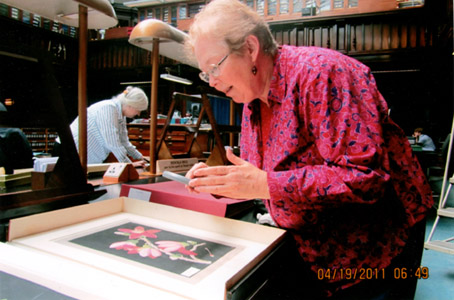 Historian Olive Jones studying one of Mary Delany's collages at the British Museum I’m always fascinated by the collage methods of other artists so I was keen to know how Mrs. Delany did it. Her tools of trade were: a filigree-handled scissors, tweezers, a bodkin (for poking holes), a flat bone folder and mortar and pestal (for grounding pigments to make watercolour paint). She re-constructed plant and floral specimens, many of which she may have grown in her own gardens, as well as whose designs she had embroidered onto fine fabrics. With the keen scientific eye of a botanist, she dissected plant specimens in order to understand their likeness so she could reproduce them through collage. Cutting them out from hand-made coloured papers or papers she painted herself, she most probably glued them down with a flour and water paste (or albumen). With my eyesight beginning to fail a bit, I’m amazed at how acute Mrs. Delany’s vision must have been to have pasted down such delicate, minute fragments of paper; equally impressive is her level of dexterity in cutting and laying out these pieces.
Molly Peacock observes that rather than being exact replicas of plants, Mrs. Delany’s floral collages are like memories, and that each work has a personality of its own. If you’d like to see these jewel-like creations to judge for yourself, you can visit the Study Room of the British Museum, as my good friend historian/artist Olive Jones (see photo) did this spring – now she has Flora Delanica mania! If you’re short on funds or time like me, you can admire them on the British Museum’s website. I’m two chapters into the book and am just loving it. I’m so taken with Peacock’s writing/research style and the way her personal history and passions intertwine with Mrs. D’s. If you like art historical biographies and collage or need further creative inspiration, I highly recommend this book.
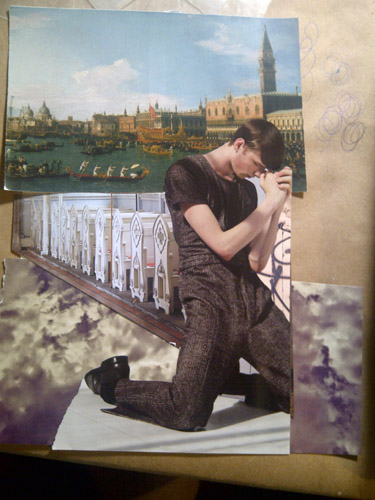 Michelle Casey, "Lost Boy", Collage in progress, July 2011 Today, I’d like to share some thoughts about a page I sort of … well, “lost”. As much as I wanted to include it in my current series of works in the Atrium Show, it won’t be there. Sometimes a precious page may be ruined when it gets glued down in an awkward fashion or when I accidentally rip a magazine fragment the wrong way. As hard as I try (and believe me I do!) to fix it, I just can’t – so a collage ends up being “lost” to me. Fortunately, I had the good sense to photograph this one, so you can still see it.
This fugitive page was very much like the boy, my brother, who inspired it. Some pages take a long time to reveal themselves to me; others seem to develop themselves almost effortlessly in my hands – this one was like the latter. I’d been collecting images of young men that resembled aspects of my brother for some time and was lucky to find a few series of magazine photographs of young men I felt might work well. A couple were even posed in the precise religious manner I had envisioned. One image in particular of a handsome young man dramatically kneeling in prayer caught my eye; that, coupled with an image of a Venetian painting by Rococo artist Canaletto, a row of pews from an old church, some ominous clouds and a graffiti fragment, I felt, created the perfect backdrop for my page. Through this idealized surrogate version of my brother I hoped to reveal a little more about his fate.
If you’ve seen my Pieces of Me I and II portfolios, you’ll notice that religious iconography plays an important role in my visual language: churches, wings, doves, halos, stars, nun’s habits, lambs, etc. all allude to my spiritual upbringing. My mixed British/Portuguese East Indian heritage is steeped in Roman Catholic tradition that goes back centuries. Like my parents and theirs before, my sisters and I were christened after the saints. My brother, Francis Gerald Serrao, was no exception. Named after each of his grandfathers as well as the infamous patron saint of Goa, St. Francis Xavier, his religious destiny was ensured. While she was expecting, my mother, a devout Catholic, prayed that one day her son would follow in the footsteps of his missionary namesake. Confused, virtually fatherless from a young age* and suffering from the lack of a stable male role model in his life, Frank turned out to be quite the opposite of a saint… he turned out to be like the rest of us mortals, quite imperfect… struggling to survive in a world that seemed harsh. By 20 he had fathered two children, became estranged from his girlfriend and was drowning in financial debt. Although he tried in his own way to make these situations better, he failed miserably. In his early 20’s, like many young men in this hopeless situation, he attempted to escape his problems by fleeing to Toronto to find work, perhaps start over and leave behind old painful ghosts. After a year or so, he mysteriously stopped communicating with us. We tried to locate his whereabouts, but found no trace of him. Was my brother lost or dead? The question still torments me. For the past decade, when a young man is found dead or shot in the area he was last known to be (Brampton, Ontario), I envision his lifeless body. His image haunts my dreams… my dream journal contains a number of nightmares about his imaginary demise. Some of these I’ve translated into journal pages (March 16, 2010, February 23, 2010)… I’ve even made a new page for the Atrium Show “Lost Souls, Part I” based on yet another dream of him.
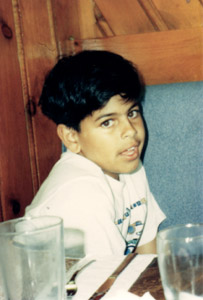 Frank Serrao about eleven years old For a time I was very close to Frank… we did everything together… he showed great promise as an artist; he had a sensitive soul. Often I wonder if we’ll ever find him. I wonder too, if he wants to be found. Like my journal page of him, he has slipped from my grasp…
*My father suffered from cancer most of my brother’s childhood; he died when Frank was eleven years old.
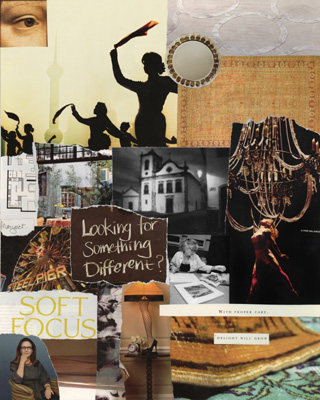 Maggie Jordan, Vision Board, April 2011, 16 x 20 inches (small texts on right side: "A Fine Balance", "With Proper Care", "Delight Will Grow") It’s time for another student spotlight. It’s such a pleasure to highlight a student who’s been so enthused by what I’ve taught them, that they just had to come back for more! Maggie Jordan, not only attended a second vision board workshop, she also recruited five of her good friends to take it! If that wasn’t enough, she found a wonderful new venue for me to teach in as well as organizing a delicious vegan potluck lunch! You can see my April blog for details/photos on that. The excitement generated by this group was so contagious, their creative energy stayed with me for weeks after I taught the class – a bonus!
This time, Maggie embarked on a third vision board journey. The previous month, she’d completed a second one for another personal project she’s working on – she’s so adventurous that girl, they don’t call her Maggie “free spirit” Jordan for nothing! 🙂 Getting back to the third… leaving her old career behind, Maggie was ready to take on a new one that would hopefully allow her to more fully utilize her creative potential and experience. Here are her reflections…
 Maggie Jordan, August 2011 Briefly, what’s your background?
I am an artist, a potter, a designer. I have been doing art for as long as I can remember. I started doing pottery at age 10 and have been experimenting in various forms of art ever since. I studied Visual and Creative Arts as well as Technical Drawing. Therefore I have a technical and creative mix to my art. I worked as a designer for a design/build company where Vision was the product I gave to my clients. I am not tied to any particular form of art and enjoy trying various mediums. I have found mixed media to be my favourite of late.
You’ve already taken a vision board workshop with me before, what compelled you to want to create another one?
My first vision board had a theme and a focus; I wanted to create another vision board to reflect the focus I was currently working towards. For me, the vision board is most effective with its own theme to reflect on in my daily life. This type of focus with visuals holds close to me throughout my daily journeys, a constant reminder of where I am heading, what I am working towards and most relevant a reminder of what is important to me. I have now done 3 vision boards with 3 different themes!
Did you have a particular vision/dream in mind before the workshop? If so, what was it? Did this vision flow from the other one?
My vision was for direction with regards to my work. I was and probably still am, in transition for my work/job, I knew change was on the horizon and I know that this can be a very exciting time for what is waiting around the corner! Since there is always lots of emotion and conflict during times of change, I wanted to have a healthy focus on where I ultimately would like to be heading in my career path. As I was faced with decisions, and the outside world was calling to me, I used my vision board to steer my inner compass.
This vision board did not necessarily flow from the other ones only that I feel the process is similar in the way I tap into my inner wishes, hopes, and dreams…
You have some pretty dynamic imagery on your board, how do you go about selecting imagery and text? What do you draw on … your gut feelings, your arts background, etc..? I love the different female characters on your board… are they all various aspects of yourself?
For me it boils down to a gut feeling thru subliminal images….I want my visuals to create emotion, and therefore have a personal meaning and purpose. Even texture is an emotion for me; these are the elements that make me feel ‘alive’ and ‘living’. My art background has given me the tools to balance my composition, also to be free and let the creative process flow without judgement or being too analytical.
I believe that I do project myself into the character images, they are how I may see myself while living within these visuals…it makes things seem not so abstract, that I can be that person, that I am that person or that I will work towards being that person, it is my projection for myself to believe in me.
Did the process of collaging reveal any new insights about you or your vision?
I love the process of collage; it has an instant appeal of personal satisfaction. What is in my head becomes visual, from my heart thru to my eyes and then with the ability to manually throw it all together. I am a tactile person, so the process of collage gives back to me through paper, glue and scissors.
Now that you have three vision boards to draw on at home, how do you deal with that? Is your current vision board working for you? If so, how?
Hahaha….I am only able to focus on one at a time, but am able to also see that my life has many facets to draw personal strength from. I have made some personal work/job changes and feel that I am still evolving thru the process, so I am currently focusing on that vision board. My first vision board is a rock for me, I see it and I know it holds the values that I take with me every day.
I think the image of the highwire trapeze artist hanging on the chandelier (middle right) gives great insight into Maggie’s indomitable spirit. Her words always fill me with inspiration! I love her approach to art making, vision boarding and life. It was great to learn more about her as we arranged the workshop. I had a chance to take in her beautiful artwork as well as finding out that she’s the third generation of women artists in her family. Upon creating her board in April, she’s recently engaged herself in an exciting new project that uses both her exceptional administrative leadership skills as well as her creative skills. I’m so happy for her and have no doubt that along with her talent and experience, her ability to visualize and realize her goal helped her get to this place. As well, I may be lucky enough to have her assist me in arranging my next opening “gala” at the Atrium Gallery in November – Oh, Maggie don’t forget to wear your tiara! 😉 I hope your latest business venture leads to many exciting career paths for you!
Other Related Student Vision Boards of Interest:
Maggie’s Vegan Potluck Vision Board Workshop
Maggie’s First Vision Board
Dragonfly Dreams Vision Board Workshop Part II
Note: To learn more about Maggie’s new work projects, you can check out her Facebook page.
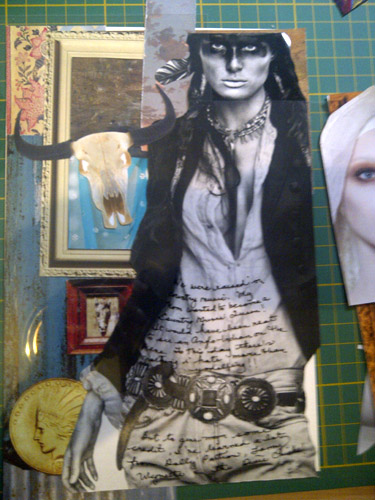 Michelle Casey, "Country Sunshine", Collage in progress, June 2011 Today I’d like to share some thoughts with you about another one of my latest journal pages, “Country Sunshine”, which was named in part by the cheerful country tune made popular by Dottie West. Late last year while taking a workshop in Arnprior, I enjoyed trading stories with another student about country music’s role in shaping our lives. Although we didn’t know each other, I thought it was cool how we both felt we were force fed country music as kids. As a result, while brainstorming ideas for journaling topics, I enthusiastically added country music to my list. While skimming through magazine pages, the image of an “Indian” Cow Girl caught my eye – she made me think of an old Merle Haggard song I’d listened to as a kid. I just knew she had to be the main character of my page and that’s how “Country Sunshine” was born. Making it took me for a fun walk down memory lane, country style…
Now many have assumed, because I’m of South Asian descent, that East Indian music must have surely filled my family home, but this couldn’t be further from the truth. In fact, my parents, Catholics of mixed European and Asian descent from India, had been raised solely on western music like: jazz (swing) and rock and roll. When we moved to Canada, my mom, a real conservative at heart, carried on the tradition of listening to good, clean music. That meant hard rock, heavy metal, even some pop and just about everything else was ruled out of our audio range – the “devil’s music”, I think she called it. She surrounded us with music, like country, that held values similar to the ones she was raised with “back home”. Not to say that we didn’t resist… in their bedrooms my sisters tuned into AM rock and pop stations while I listened to all French radio … anything but country! On TV we watched country music shows like: The Family Brown, Hee Haw, The Tommy Hunter Show and our all-time favourite family drama series: The Waltons (NOT!) Okay, okay, I’ll admit John-Boy’s heart-felt writing kinda grew on me! Over the years, country hits became engrained in my head. Songs like: Johnny Cash’s hilarious “A Boy Named Sue”; Merle Haggard’s “Cherokee Maiden”; Dolly Parton’s “Coat of Many Colors” and Tammy Wynette’s “D-I-V-O-R-C-E” – real tearjerkers! I also remember really disliking Slim Whitman’s yodelling in “Indian Love Call”… later I learned to appreciate his music and love his rendition of “I Remember You”… plus I have to admit, he was quite a spiffy dresser, too. I thought it sooo hilarious when director Steven Spielberg used Whitman’s yodelling from “Indian Love Call” to kill off the aliens in his film: Mars Attacks. I don’t think anyone laughed harder than me in the movie theatre seeing those ET heads explode! I thought Spielberg and I had to be real kindred spirits to make that deadly musical connection. 🙂
In hindsight, making this page and listening to a whole host of other favourite country songs made me realize there was so much tied to those seemingly “simple” country tunes. Through their music, Parton and Wynette relayed important life lessons about economic class, fitting in and women’s issues in society; while Cash and Haggard brought topics of race and interracial* romance into the open. I loved “Cherokee Maiden” so much precisely because it was about a white cowboy professing his undying love for a beautiful “Indian” lady – if there was hope for her, then there was hope for me! Unlike today, in the 1970’s, interracial relationships were not as prevalent. Anyway, I hope these thoughts and music spur some good country music memories in you too. If they do, I’d sure love to hear about them.
* I have great respect for aboriginal cultures, if you have other views about “Cherokee Maiden” or any other songs I’ve mentioned please write; I’d be interested to hear your comments.
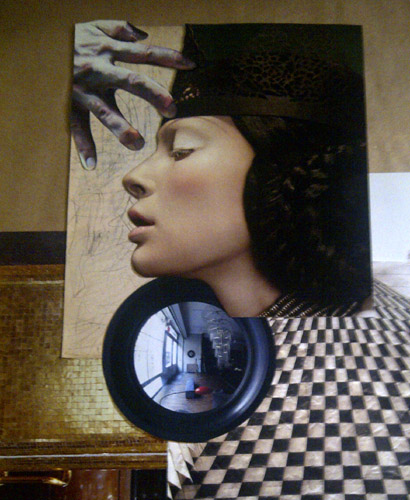 Michelle Casey, "Forces Compel Me", Collage in progress, July 2011 There’s a popular myth out there that states only some of us have the “natural” ability to be creative. My Aunt always laments that her daughter doesn’t have a “natural” talent for making art like me; this never fails to irk me. I firmly believe that although we may not have all been born with an aptitude to produce art that that doesn’t mean we can never develop the talent for it. Furthermore, being creative doesn’t just include being able to make art… remember that time you spontaneously decided to add a dash of something extra to spice up a recipe? Or the time you composed a digital music playlist of your favourite tunes? Well, right then and there you were engaging creative acts! Like other professionals, artists practice on a regular basis to improve their skills and expand their imaginations and knowledge to extend the boundaries of art. If that’s how we get better, than that’s how people who don’t think they’re creative can also unlock their creative potential!
This is the impetus for Shelley Carson’s book: Your Creative Brain: Seven Steps to Maximize Imagination, Productivity and Innovation in Your Life. Because our world’s changing so rapidly due to new technologies and globalization, Carson feels it’s more important than ever to be able to develop our creative powers in order to develop new survival skills to improve our personal and professional lives in this twenty-first century.
Directed at wanna-be creatives and stifled creatives alike, Carson’s book revolves around the CREATES brain states model. She devotes a chapter to the seven creative brain states in this model: Connect, Reason, Envision, Absorb, Transform, Evaluate, and Stream (a perfect acronym!). Unlike previous texts on creativity I’ve read which stress the right-brain’s role in accessing the more artsy/emotional side of our being, she reveals both sides of the brain, left and right, are crucial to developing our creative ideas/goals at various stages and nurturing them to fruition. Having readers assess early on in the text which of the brain states they feel most comfortable in and which ones they need to improve on, helps them navigate more easily through the book. If you don’t like assessment tests, you can also discover this by reading each of the short chapters assigned to visualizing and defining each creative area of the brain. At the end of every chapter she provides several short exercises you can do on a daily/weekly basis to develop each brain state. For example, to stimulate the Absorb brain state, which increases your ability to observe details of the world around you, she has you exploring your personal environment through the senses, trying new foods as well as incorporating various techniques into exercise, sleep and meditation rituals. As a further incentive to doing these exercises, she also provides a token point reward system to spur readers on.
I enjoyed reading Carson’s clear, humorous writing style and found it to be an excellent read for the lay person. Learning how brain states have helped diverse creatives from Frida Kahlo, J.D. Salinger and Tchaikovsky to Albert Einstein was exciting and inspiring. That her findings can be made concrete through fun, easy and practical exercises is amazing. I’d already found some of her suggestions such as taking walks, surrounding oneself within nature and using instrumental music to induce a productive creative state of mind beneficial, and discovered many more great ideas in her book. I particularly enjoyed reading the chapters on the Stream and Transform brain states. By improving our Stream brain state, we can learn how to maintain a spontaneous flow of ideas to get ourselves “in the zone” while creating. Using the Transform brain state, we can learn how to constructively channel and integrate our negative emotions into our work. Some of you may find the chapter on the Envision brain state, which helps in visualizing and manipulating mental images, useful for vision board projects. Furthermore, I like Carson’s suggestion that we view the problems we encounter in our daily lives as opportunities for change, creativity and innovation. Throughout the book she convincingly conveys how developing our creative powers can help us not only in producing art but also in improving other aspects of our lives – she sees us all as potential inventors and innovators in the making! After trying out a few of her exercises while working on pieces for my latest show, I found they helped me to focus my attention for longer periods of time on my work even when several crises threatened to de-rail me; her book was well worth the purchase — I highly recommend it!
Also check out Women’s Health magazine for a good overview and exercise suggestions from the book.
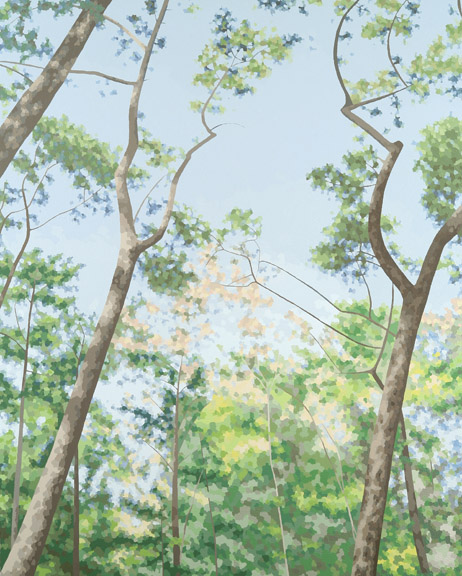 Elaine Coombs, "Once in a Song", Acrylic on canvas over panel, 50 x 40 inches, 2011 Hello! It’s been nice to take a break from blogging to concentrate (almost) exclusively on producing works for my upcoming Atrium Gallery show. Some of my friends thought I was away on vacation, but no such luck! I was here in my subterranean studio slogging away collaging!
It was exciting, nevertheless, to delve into making journal pages almost every day… to release emotions, past demons, stress and the whispering fragments of stories that have been filling my head for the last six months. As a bonus, I set and surpassed my goal of creating 25 new pages; a number of which will be in my show.
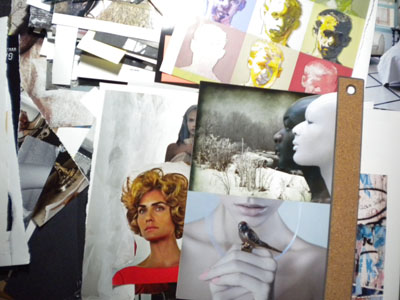 Images crossing paths on my table top... It was scary starting to journal again every day with no excuses. I was hoping to be in the most relaxed head space possible to create these pages, however, since April, I’ve been dealing with a record-breaking series of sad news events that have affected me deeply. In the past, this type of scenario would certainly have paralysed me. This time, I promised myself and Kevin, no drama! I wouldn’t let these feelings take over my entire creative head space. Instead, I would do what I could realistically in the real world to deal with them and also channel these feelings into my work. So I hurled myself wholeheartedly into production mode. On days when I was feeling “off”, I worked and worked until I could kick start my sense of creativity… I sifted through magazine fragments on my work tables for hours, and took walks when I felt stuck. Upon returning from these excursions I almost always saw the fragments anew… come alive… some virtually assembled themselves before my very eyes, while others required a careful tweak or two (or three, or… ) to complete. To my amazement, following this working rhythm, page after page came together in no time. As a prelude to the show, every week or so, I’ll be posting brief notes on some of the pages I’ve made. Today I’ll begin with “The Tree Whisperer” a portrait of my artist/friend Elaine Coombs.
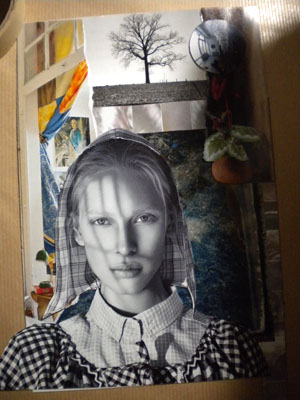 "The Tree Whisperer" collage in progress... The Tree Whisperer
Last month I was delighted to receive a painting of Elaine’s as a gift. As well, I had a chance to review her latest series of works from her current solo show: “Blue Skies”; paintings inspired by the trees in San Francisco’s Golden Gate Park. The show’s title was plucked straight from an Irving Berlin tune sung by Ella Fitzgerald. It wasn’t long before “Blue Skies” got under my skin. Reading Elaine’s artist statement and blog, I found myself fascinated by the way she absorbs her subject matter before painting it. Having a chance to also admire her work first-hand, I was smitten by the small dots of colour and elegant lines she uses to compose her beautifully textured, light-filled paintings where trees from various forests dance, sway and offer insight. I love the way Elaine crafts her titles as well – animating her subject matter even further. Using techniques akin to Post-Impressionist Pointillist painter Georges Seurat and Contemporary Photorealist Chuck Close, through the microcosm of tiny dots of paint, in her own unique way, Elaine makes visible the hidden language of trees. On display in a variety of public spaces in California, Elaine’s treescapes bring out the sense of beauty and optimism found in nature. Their grand scale enhances their sense of sacredness giving one a sense of being embraced by the forest or walking through a natural cathedral. Touched by the thoughtfulness and precision of her paintings, I felt compelled to create a page about my friend, “the tree whisperer”, when a fragment of a tree, an enigmatic woman and window pane crossed paths on my studio table.
I’ve always been moved by nature, especially trees. On a trip to Banff, Alberta nearly a decade ago, I found myself soothed and mesmerized by them. Ever since then I’ve viewed them as spiritual sentinels. If you feel this same way, I highly recommend you wander through a virtual tour of Elaine’s paintings.
|
|























